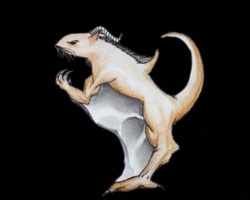A magazine where the digital world meets the real world.
On the web
- Home
- Browse by date
- Browse by topic
- Enter the maze
- Follow our blog
- Follow us on Twitter
- Resources for teachers
- Subscribe
In print
What is cs4fn?
- About us
- Contact us
- Partners
- Privacy and cookies
- Copyright and contributions
- Links to other fun sites
- Complete our questionnaire, give us feedback
Search:
Sketching science

Scientists often find themselves doodling on scraps of paper, or sketching out ideas on a whiteboard, but that’s not really what science is about – is it?
In fact, scientists have to be highly creative and all that doodling and sketching both helps them share ideas and plays a vital role in producing flashes of inspiration in the first place.
Bongo playing, Nobel winning physicist Richard Feynman’s development of ‘Feynman Diagrams’ is a classic example – it helped revolutionise the way scientists think of quantum physics, the science of subatomic particles. Feynman Diagrams are just a simple way of using pictures to visualise the quantum level processes that occur.
Queen Mary computer scientist Pat Healey and Tessa Garland, an artist from the Bow Arts Trust, are studying just how big an impact drawing can have on science.
Tessa is spending time exploring the way scientists use drawings in their work. They draw in a whole bunch of ways: on paper, whiteboards and computers. Computer scientists have borrowed observational techniques like this from the social sciences. It’s a way they gather data about the way people behave in real situations so that those activities can be supported using computers. Pat and Tessa are then analysing the kind of images and styles scientists use to represent their results. From this, Tessa explores different ways to draw the same things, even creating 3D versions. The idea is to provide the scientists with new techniques for exploring the problem spaces they are working on. Drawing is being used to uncover new facets of scientific problems and to uncover new ways to get to solutions.
The ultimate aim is to communicate the results to both other scientists and the public in exciting ways, using for example interactive drawing games. Some of the ideas were tried out as part of the 2007 'Big Draw' run by the Campaign for Drawing, allowing kids to get involved. For example, children explored developmental processes with artist Albert Potrony by creating their own hybrid creatures including animations of their creatures developing from a fertilised egg to a baby.
Not all scientists may realise it but drawing is an important part of science so if you are stuck for an idea, pick up a pencil. That missing flash of creativity might be in your next doodle.


